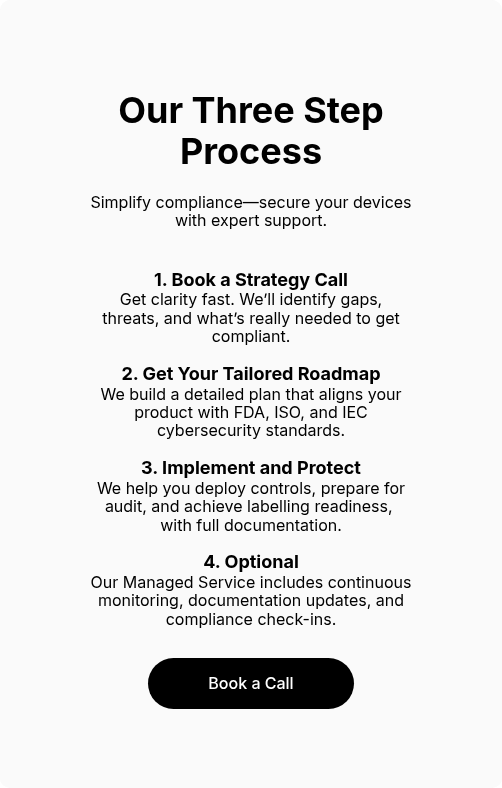Medical Device Cybersecurity Labelling
Protect Patients, Ensure Compliance, Scale Securely
What is Medical Device Cybersecurity Labelling?
Cybersecurity labelling is a standardised way to verify that a connected medical device meets defined security requirements. It communicates to regulators, healthcare providers, and patients that the device has been tested against known cybersecurity threats and adheres to best practices such as encryption, access controls, and secure software updates.
From pacemakers to insulin pumps, connected medical devices are changing lives. But as innovation grows, so does exposure to cyber threats. Attacks on medical devices are becoming more common, and regulators around the world, like the FDA, EU MDR, and ISO/IEC standards bodies, are tightening their requirements. Devices must now be designed, tested, and labelled with cybersecurity in mind.
For digital health companies, cybersecurity labelling isn’t just a tick-box exercise. It’s about building trust, avoiding delays to market, and scaling securely.
Why Cybersecurity Labelling Now?
Cyber threats are at an all-time high, and the healthcare sector is a top target. In response, regulators have introduced detailed requirements such as the FDA’s Premarket Cybersecurity Guidance and the new ISO 81001-5-1 standard.
A cybersecurity label provides visible proof that key security controls are in place. It helps companies meet regulatory requirements and gives investors and clinical partners confidence in the product’s safety. It also reduces the risk of delays or rejections during the approval process.
The Role of Labelling in Patient Safety and Data Privacy
When a connected device is breached, the outcome can be life-threatening. Attackers can hijack infusion pumps, change cardiac data, or disrupt treatments. In 2017, the FDA recalled nearly half a million pacemakers due to vulnerabilities that allowed hackers to reprogram them and drain their batteries.
Cybersecurity labelling helps reduce the risk of such attacks by ensuring devices are tested and secured before reaching patients. It also supports compliance with key regulations like HIPAA, GDPR, and FDA guidelines by verifying that privacy and safety are built into the design from the start.
Key Components of Cybersecurity Labelling
To earn a cybersecurity label, your device’s security must be clearly designed, tested, and validated. Labelling brings together four core areas, each vital to building trust with regulators, clinicians, and patients.
The first step is identifying threats. This involves mapping your device’s full ecosystem—everything from hospital networks and cloud platforms to mobile apps and third-party APIs. You’ll need to spot possible entry points for attackers, such as unsecured data transfers, weak authentication, or outdated software libraries. This threat model is essential to tailoring your security strategy to real-world risks.
Once threats are identified, the next step is mitigation. You’ll need to implement layered security controls to prevent unauthorised access, data leaks, and tampering. This might include multi-factor authentication for both users and admins, encryption of patient data in transit and at rest, secure software updates, and role-based access controls with full audit logs. Your cybersecurity label should clearly explain which defences are in place and how they help protect patient safety.
Then comes testing and validation. Before launch, the device must be tested against the threats identified earlier. This usually includes penetration testing, vulnerability scanning of firmware and infrastructure, code reviews to catch insecure practices, and red team exercises to simulate advanced threats. These steps show regulators that your security isn’t just theory—it’s proven. Your label will reflect these test results and demonstrate your product’s resilience.
Finally, your labelling must align with the right regulations. For the US market, this includes the FDA’s Premarket Cybersecurity Guidance, which outlines specific expectations for design controls and labelling content. If you’re targeting Europe, you’ll need to meet EU MDR Annex I safety and performance requirements. Internationally, ISO/IEC 81001-5-1 is becoming the standard for cybersecurity in health software. Aligning with these frameworks helps you avoid friction during audits and shows buyers your product meets global expectations.
FDA and International Standards: What You Must Know
The FDA requires cybersecurity labelling as part of the premarket approval process for many connected devices. Labels must explain which cybersecurity design controls have been implemented, how risk is being managed, and what users should do to operate the device securely.
Outside the US, international regulators are moving in the same direction. Standards like ISO 27001, IEC 62304, and ISO 14971 are being adopted around the world. Labelling that aligns with these standards can make multi-market approval easier and boost your product’s global credibility.
Need help or advice on securing your medical device and navigating compliance?
Get in touch with our cybersecurity and regulatory experts today.
%20(1)%20(1).png?width=309&height=69&name=image-001%20(2)%20(1)%20(1).png)



